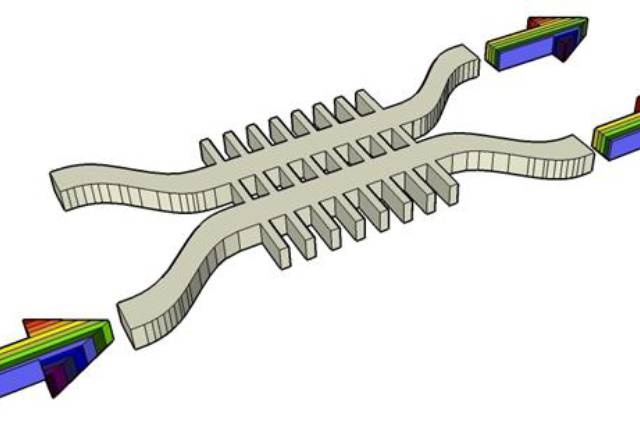WAVEGUIDE COUPLING DEVICE AND METHOD FOR DESIGNING SAME
Description
Integrated optics, in which it is a matter of applying microelectronic techniques to make integrated photonic circuits capable of manipulating light on a micro or nanometric scale, are finding a large number of applications such as, for example, the realization of lasers and photodetectors, spectrometers, circuits communications or biosensors. Light travels inside these circuits through waveguides. One of the most used components in these circuits are couplers, which are circuits capable of dividing or combining power between different input guides, imposing specific phase shifts between the waves coupled to each output guide. More particularly, in integrated optics two types of couplers are generally used: directional couplers (DC) and multi-modal interference couplers (MMI). The former have the advantages of simple design and arbitrary division ratios, while the latter generally offer better manufacturing tolerances and a greater range of operating wavelengths (bandwidth). One of the problems of these couplers is precisely their reduced bandwidth, since, although several techniques have been proposed to improve it, they all have poorer performance and an excessive increase in size as a counterpart.
The present invention offers a waveguide coupling device that improves, by a factor of x5, the bandwidth of currently existing devices while maintaining the same performance and size.
Advantages
The main advantage of the present invention lies in the fact that it is a device that considerably increases the bandwidth with respect to existing devices today, without entailing an increase in the size of the same and without its response in phase changing. see degraded.
Likewise, it should be noted that the present invention proposes the use of the dispersive properties of the networks, that is, the variation of their properties with the operating wavelength of the device.
Uses and Applications
The present invention belongs to the field of integrated optics and may have applications in the manufacture of lasers, spectrometers for various applications, biosensors, and optical communication circuits.
Keywords
Sectors
Areas
Patent Number
ES2379058 Expediente
Applicants
UNIVERSIDAD DE MÁLAGA
Inventors
ROBERT HALIR , ALEJANDRO MAESE NOVO, ALEJANDRO ORTEGA MOÑUX, IÑIGO MOLINA FERNANDEZ
Filing Date
23/02/2012
Protection Level: National (Spain)
Processing Status: Spanish patent








